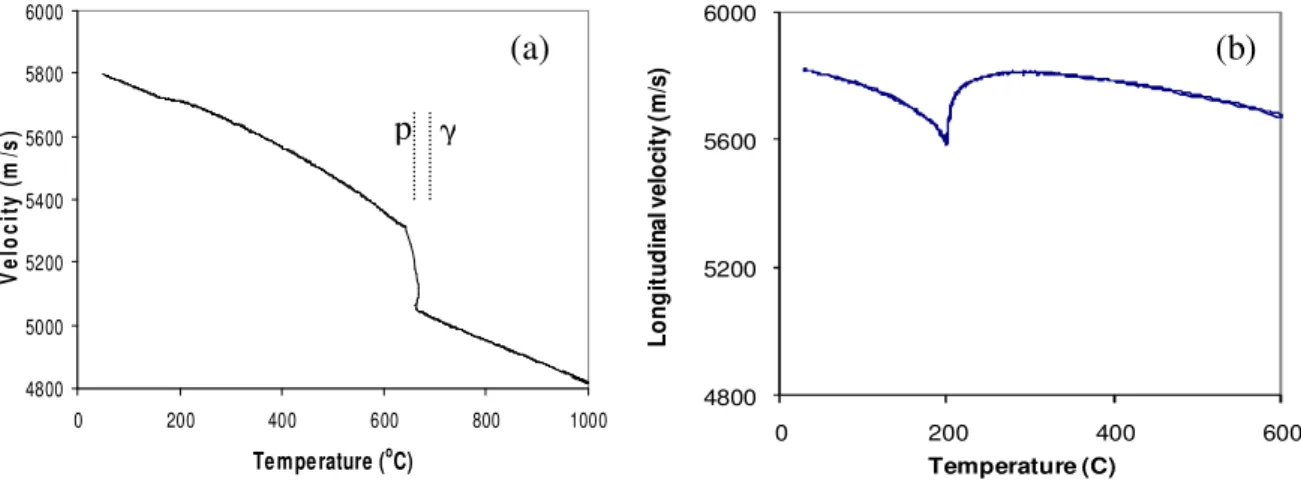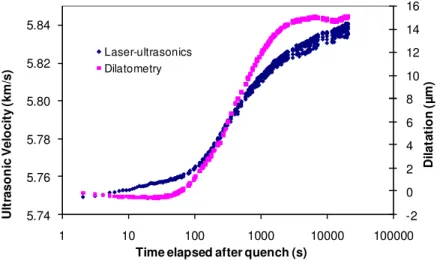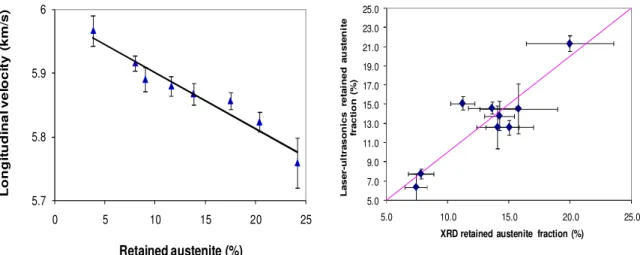Publisher’s version / Version de l'éditeur:
Vous avez des questions? Nous pouvons vous aider. Pour communiquer directement avec un auteur, consultez la première page de la revue dans laquelle son article a été publié afin de trouver ses coordonnées. Si vous n’arrivez pas à les repérer, communiquez avec nous à PublicationsArchive-ArchivesPublications@nrc-cnrc.gc.ca.
Questions? Contact the NRC Publications Archive team at
PublicationsArchive-ArchivesPublications@nrc-cnrc.gc.ca. If you wish to email the authors directly, please see the first page of the publication for their contact information.
https://publications-cnrc.canada.ca/fra/droits
L’accès à ce site Web et l’utilisation de son contenu sont assujettis aux conditions présentées dans le site LISEZ CES CONDITIONS ATTENTIVEMENT AVANT D’UTILISER CE SITE WEB.
1st International Symposium on Laser Ultrasonics: Science, Technology and Applications [Proceedings], pp. 1-6, 2008
READ THESE TERMS AND CONDITIONS CAREFULLY BEFORE USING THIS WEBSITE.
https://nrc-publications.canada.ca/eng/copyright
NRC Publications Archive Record / Notice des Archives des publications du CNRC :
https://nrc-publications.canada.ca/eng/view/object/?id=b3b622d8-c3d0-4a3f-bc3d-e491d6b3d786 https://publications-cnrc.canada.ca/fra/voir/objet/?id=b3b622d8-c3d0-4a3f-bc3d-e491d6b3d786
NRC Publications Archive
Archives des publications du CNRC
This publication could be one of several versions: author’s original, accepted manuscript or the publisher’s version. / La version de cette publication peut être l’une des suivantes : la version prépublication de l’auteur, la version acceptée du manuscrit ou la version de l’éditeur.
Access and use of this website and the material on it are subject to the Terms and Conditions set forth at Laser-Ultrasonic Monitoring of Metallurgical Transformations in Advanced Ultra-High Strength Steels
Laser-Ultrasonic Monitoring of Metallurgical Transformations in
Advanced Ultra-High Strength Steels
Silvio E. KRUGER, André MOREAU and Jean-Pierre MONCHALIN
Industrial Materials Institute, National Research Council of Canada Boucherville, Québec, Canada; Phone: +1 450 641 5076, Fax +1 450 641 5106;
silvio.kruger@cnrc-nrc.gc.ca, andre.moreau@cnrc-nrc.gc.ca, jean-pierre.monchalin@cnrc-nrc.gc.ca
Abstract
This paper discusses the use of laser-ultrasonics to monitor the metallurgical transformations of advanced high-strength steels. In this technique, acoustic waves are generated and detected in the material by use of lasers. The ultrasonic velocity can sense the austenite formation/decomposition in real time. Unlike dilatometric measurements the ultrasonic velocity measurements show little influence of the carbon concentration in solid solution and measurements can be made on-line. Also, they can be used to determine the fraction of retained austenite during and after cooling. The ultrasonic response of iron carbides is also investigated and discussed. We present examples such as monitoring the austenite fraction on transformation-induced plasticity (TRIP) steels during the bainitic transformation and at room temperature. Comparison with other sensing techniques and on-line implementation is discussed.
Keywords: Laser ultrasound, real-time monitoring, TRIP steels, austenite decomposition, on-line NDT
1. Introduction
Advanced high strength steels are obtained by a combination of chemical composition and complex thermo-mechanical processing that provide the desirable microstructure and phase composition. Obtaining uniform products according to customers’ expectations is very challenging in real production lines, especially if the production lines were not originally designed for advanced high strength steels manufacturing. On-line sensors can greatly help to adjust production parameters to guarantee uniformity by providing real-time information of the steel microstructure. The non-contact character of laser-ultrasonics, makes this technique particularly fitted to real-time monitoring of products in the steel industry. Ultrasonic waves are generated by a pulsed laser (typically of a few nanoseconds of duration and with energy below one Joule) and the detection is realized by another laser (long pulse or continuous) and an interferometer that, together, probe ultrasonic displacements at the material’s surface [1,2]. In addition to the non-contact nature of the laser-ultrasonic method, the technique is broadband (this is especially interesting for frequency domain analysis and for high resolution in the time domain) and has fewer constraints on material geometry (material surface is the transducer: curved surfaces are allowed). The use of high power detection lasers coupled to speckle-insensitive interferometers allows for good sensitivity even when testing rough or poorly reflective surfaces of industrial products.
Laser-ultrasonics has been used both in laboratory [3] and industry [4] to monitor, among others, grain size and grain growth [4-7], recrystalization and texture [7-10] and phase transformation [11,12]. The technique and has been made commercially available and its application for the tubing industry [4] has been used in metallurgical industries in several locations around the world. In this paper, the application of laser-ultrasonics for the monitoring of advanced ultra-high strength steels is presented, with emphasis on the measurement of austenite fraction.
2. Basics of Ultrasonic Interaction with Steel Microstructure
The ultrasonic wave velocity and attenuation depend on some properties of the material where the wave is being propagated and are the basis of ultrasonic characterization of materials. For steels, the velocity depends mainly on the steel composition, phase fraction and texture and the attenuation is mostly related to grain size. The dependence of the ultrasonic velocity on phase composition in steels will be detailed further in this paper.
The iron single crystal has a significant anisotropy and if the grain orientation in steel is not completely random, there will be an overall anisotropy or texture that can be sensed by the ultrasonic velocity. Since texture changes often occur during recrystallization, this parameter can be used to monitor this metallurgical transformation both after cold rolling [9] and hot deformation [7,10].
Grain size determination is a classical application of ultrasound to microstructure characterization. The mechanism of acoustic wave scattering by grains is well-known and models for attenuation in a wide frequency range are available. Laser-ultrasonics can monitor austenite grain size evolution at high temperatures in-situ and in real time both in laboratory [5,6] and in production lines [4]. Austenite grain size can determine to a significant extent the mechanical properties of steels, but measuring the grain size of the prior austenitic phase at room temperature by conventional metallographic methods can be very challenging. Often the microstructures are more complex than a log-normal size distribution of single phase, equiaxed grains, and neither the definition of grain size nor its relationship to the model grain size parameter is straightforward. Even in this case the ultrasonic evaluation can be very useful, giving a quantitative measurement of how coarse (or fine) the microstructure is.
Simultaneous measurements of more than one microstructural parameter are possible when these parameters modify different ultrasonic parameters (eg. attenuation for grain growth and velocity for texture). The most important and most obvious advantage of real-time monitoring of metallurgical transformations by laser-ultrasonics, as compared to off-line techniques like metallography and x-ray diffraction, is time saving. It provides almost continuous measurements (up to a hundred measurements per second, depending on the laser repetition rate) that eliminate interruptions of the thermal cycle and subsequent sample preparation for metallographic or other characterization technique. Since the ultrasound propagates through the thickness of the material, the measured property is averaged over the volume where the ultrasound propagates while most other techniques are limited to surface measurements. Because the technique naturally provides an average bulk measurement, it does not provide as detailed information as, for example, metallography. On the other hand, measuring only a few average bulk parameters can be advantageous since it facilitates the analysis of the large amount of data collected. Although there are basically only two parameters to be measured, the attenuation and the velocity, additional information can be found in their dependence on frequency. Also, measurements using other wave modes, like shear waves, are possible.
3. Austenite Decomposition Monitoring
The ultrasonic velocity dependence on the phase fraction of a multiphase compound is a function of elastic constants, density and the morphology (geometry) of the constituent
phases. For constituent phases of similar elastic properties and densities, these models can be greatly simplified to a volume-fraction-weighted average of individual constituent velocities, and they become independent of phases morphology. The most common steel phases have similar elastic moduli and densities. The ultrasonic velocity
V of the compound can then, with a good approximation, be expressed by a law of mixtures, γ γ α αV f V f V f V f V = + M M + Fe3C Fe3C + (1)
where fi is the volume fraction and Vi is the velocity for the i-phase (Σfi = 1). The steel phases being considered are ferrite (α), martensite (M), cementite (Fe3C) and the remaining (or retained) austenite (γ). At room temperature, the ultrasonic velocity for ferrite and martensite is about 5900 m/s, for cementite is about 5850 m/s while for austenite is about 5600 m/s. The velocity of each phase has its own temperature dependence. For example, Fig. 1a shows the ultrasonic velocity measured during cooling for an almost pearlitic steel (1074) where the phase transformation takes place on a narrow range of temperature at about 650 °C. Figure 1b shows the velocity for cementite, where a magnetic transformation occurs at about 200 °C.
For compounds of more than two components (often the case for steels), Eq. 1 does not permit the volume fraction determination for each phase because there are more unknown variables (the various fractions) than known variables (the measured velocity). This also is the limitation for dilatometry, where the specific volume of each phase as a function of temperature is known, but only one parameter is measured (the sample length). However, in practice, the determination of more than two phases is often possible because they do not transform simultaneously. For example, a hypo-eutectoid steel, when cooled at low cooling rates, has the austenite-to-ferrite transformation completed before the austenite-to-pearlite transformation takes place.
Figure 1. Ultrasonic velocity dependence on temperature for (a) pearlitic steel and (b) cementite.
In a previous paper [11] a simplified lever-rule method to monitor austenite decomposition by laser-ultrasonics was proposed. By this method, the velocities of
4800 5000 5200 5400 5600 5800 6000 0 200 400 600 800 1000 Temperature (oC) V e lo c it y ( m /s ) p γ (a) 4800 5200 5600 6000 0 200 400 600 L o n g it u d in a l v e lo ci ty ( m /s ) Temperature (C) (b)
ferrite and martensite are assumed to be the same and the cementite volume fraction is assumed to be small. Figure 2a shows the ultrasonic velocity dependence for the ferrite and austenite together with the velocity measured during cooling for a low alloy steel. The simple lever-rule method applied to this case results into the austenite decomposition curve shown in Figure 2b, that agrees relatively well with the result of dilatometry. The comparison between the laser-ultrasonic and dilatometric techniques for austenite decomposition monitoring can be found in reference 11.
The monitoring of isothermal bainitic transformation in a TRIP steel by the ultrasonic velocity is shown in Figure 3 with the dilatometric measurements. Differences between the techniques are noticeable. The reason for the disagreements need additional measurements by an independent technique, but could at least in part be related to the sensitivity of the dilatometric technique on the carbon enrichment of the austenite.
Figure 2. (a) Ultrasonic velocities for ferrite (solid line), austenite (dotted line) and measured for low alloy steel during cooling (line + symbol) and (b) austenite fraction determined by the velocity curve
(solid line) shown in (a) and determined by dilatometry (squares).
Figure 3. Ultrasonic velocity (blue diamonds) and dilatation (pink squares) evolution during an isothermal bainitic transformation at 300 °C in a TRIP steel.
4800 5000 5200 5400 5600 5800 0 200 400 600 800 1000 Temperature (C) U lt ra s o n ic v e lo c it y ( m /s ) Ferrite Austenite steel sample 0 0.1 0.2 0.3 0.4 0.5 0.6 0.7 0.8 0.9 1 0 200 400 600 800 1000 Temperature (C) A u s te n it e F ra c ti o n Dilatometry Laser-ultrasonics -2 0 2 4 6 8 10 12 14 16 5.74 5.76 5.78 5.80 5.82 5.84 1 10 100 1000 10000 100000 D il a ta ti o n ( µ m ) U lt ra s o n ic V e lo c it y ( k m /s )
Time elapsed after quench (s) Laser-ultrasonics
3 Retained Austenite Measurements and Advanced Steels
TRIP (Transformation-Induced Plasticity) steels are one of the most promising new generation of steels. They have typically 10 to 20% of retained austenite in their microstructure. The retained austenite plays a major role on the exceptional mechanical properties obtained with these steels. Experimental methods to determine the retained austenite fraction on the microstructure have been a recurrent challenge for metallurgists. They include x-ray diffraction, optical microscopy and magnetic saturation. These methods are not well-suited for on-line measurements. However, a technique based on laser-ultrasonics could be adapted to on-line measurements.
Figure 4a shows the dependence of the ultrasonic velocity (longitudinal mode) on the retained austenite fraction. The correlation found is remarkable considering that the TRIP steel samples are from different compositions with the retained austenite measured by different techniques. In another series of measurements with samples provided by different steel producers, it was found that the effect of different texture was not negligible. But with the simultaneous measurement of a longitudinal and a shear velocity, a texture independent parameter can be calculated [8]. Figure 4b shows the comparison of the retained austenite fraction determined by the texture-independent laser-ultrasonics parameter and the austenite fraction measured by x-ray diffraction. The correlation found can be regarded as very good considering the large inaccuracies often associated to retained austenite measurements. As shown by the results of Figure 3, laser-ultrasonics can monitor the austenite fraction during the bainitic transformation. This makes the technique especially attractive for real-time measurements of TRIP steels in the laboratory and on production lines.
Figure 4. (a) Velocity as a function of retained austenite fraction and (b) retained austenite fraction determined by x-ray diffraction (XRD) and by laser-ultrasonics.
4 Conclusion
Laser-ultrasonic application examples presented demonstrate the ability of the technique to monitor metallurgical transformations, and particularly the austenite decomposition,
5.7 5.8 5.9 6 0 5 10 15 20 25 L o n g it u d in a l v e lo c it y ( k m /s ) Retained austenite (%) 5.0 7.0 9.0 11.0 13.0 15.0 17.0 19.0 21.0 23.0 25.0 5.0 10.0 15.0 20.0 25.0 L a s e r-u lt ra s o n ic s re ta in e d a u s te n it e fr a c ti o n ( % )
which is especially useful for advanced high strength steels like TRIP steels. As a truly non-contact technique, laser-ultrasonics can be used for hot and/or moving parts, which make it attractive for real-time monitoring of materials in both laboratory and steel production plants.
References
1. For a general textbook see: Scruby, C.B. and Drain, L.E. Laser-Ultrasonic:
Techniques and Applications, Adam Hilger, Bristol, UK, 1990.
2. J.-P. Monchalin ‘Laser-Ultrasonics: from the Laboratory to Industry’ Review of the
Quantitative Nondestructive Evaluation, Vol. 23, America Institute of Physics, pp.
3-31, 2004.
3. S. E. Kruger, A. Moreau, C. Bescond and J.-P. Monchalin ‘Real-time sensing of metallurgical transformations by laser-ultrasound’ Proceedings of the 16th World
Conference on Nondestructive Testing, Montreal 2004.
4. S. E. Kruger, G. Lamouche, J.-P. Monchalin, Robert Kolarik II, G. Jeskey and Marc Choquet ‘On-line Monitoring of Wall Thickness and Austenite Grain Size on a Seamless Tubing Production Line at The Timken Co.’ Iron and Steel Technology, 2 pp. 25-31, 2005.
5. M. Dubois, M. Militzer, A. Moreau and J. Bussiere ‘A New Technique for the Quantitative Real-time of Austenite Grain Growth in Steel’ Scripta Materialia 42, pp. 867-874, 2000.
6. Kruger, S. E.; Moreau, A.; Lamouche, G. ‘Monitoring Austenitic Grain Growth Kinetics by Laser Ultrasonics’ Proceedings of the First Joint International
Conference on Recrystallization and Grain Growth, Gottstein, G and Molodov, D.
(eds), Springer, pp. 583-588, 2001.
7. S. Sarkar, A. Moreau, M. Militzer and W. J. Poole Evolution of Austenite Recrystallization and Grain Growth Using Laser Ultrasonics Metallurgical and
Materials Transactions A: Physical Metallurgy and Materials Science 39 A, pp.
897-907, 2008.
8. A. Moreau, D. Lévesque, M. Lord, M. Dubois, J.-P. Monchalin, C. Padioleau and J. F. Bussière ‘On-Line Measurement of Texture, Thickness and Plastic Strain Ration Using Laser Ultrasound Resonant Spectroscopy’ Ultrasonics 40, p. 1047-1056, 2002. 9. S. E. Kruger, G. Lamouche, A. Moreau and M. Militzer ‘Laser Ultrasonic
Monitoring of Recrystallization of Steels’ Materials Science and Technology 2004
Conference Proceedings, pp. 809-812, 2004.Ali Smith, Silvio E. Kruger, Jilt Sietsma
and Sybrand van der Zwaag ‘Laser-ultrasonic Monitoring of Austenite Recrystallization in C-Mn Steel’ISIJ Int., 46, pp. 1223-1232, 2006.
10. S. E. Kruger and Edward B. Damm ‘Monitoring Austenite Decomposition by ultrasonic velocity’ Materials Science & Engineering A 425, pp. 238-243, 2006. 11. Marc Dubois, André Moreau, and Jean F. Bussière. “Ultrasonic Velocity
Measurements During Phase Transformations in Steels Using Laser-Ultrasonics.”


